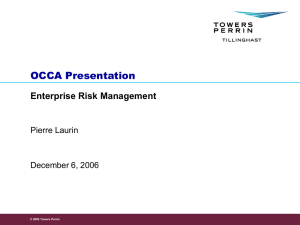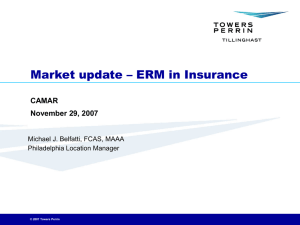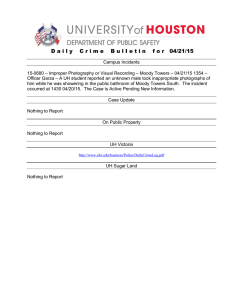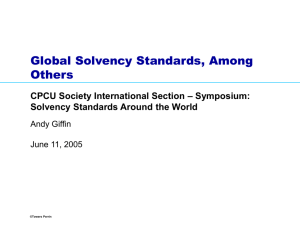Market update – ERM in Insurance Casualty Actuaries in Reinsurance
advertisement
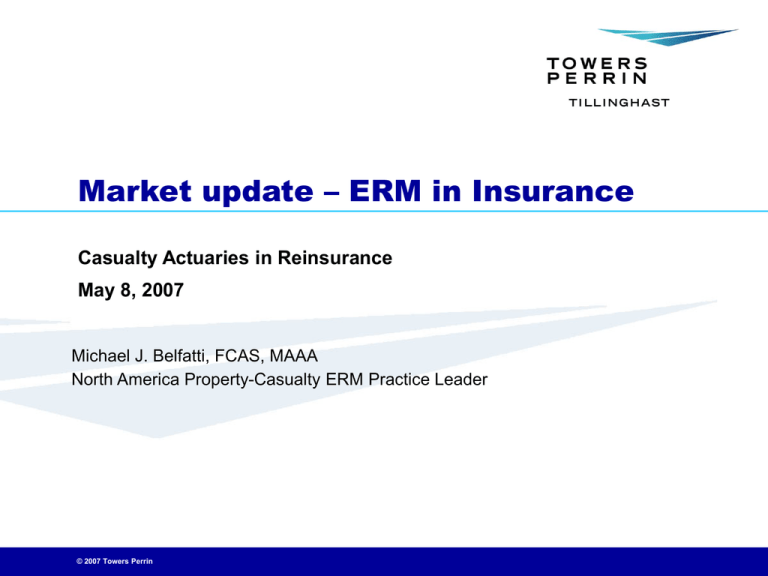
Market update – ERM in Insurance Casualty Actuaries in Reinsurance May 8, 2007 Michael J. Belfatti, FCAS, MAAA North America Property-Casualty ERM Practice Leader © 2007 Towers Perrin ERM in the Property-Casualty insurance sector Agenda Rating agency developments Company perspectives and activities ERM in strategic decisions On the horizon… ERM questions © 2007 Towers Perrin Proprietary and Confidential Not for use or disclosure outside Towers Perrin and its clients 1 Rating agency developments Framework updates AM Best draft ERM framework S&P economic capital model review framework Controls and portfolio risk awareness > capital modeling at this stage Priorities / Context-Appropriate ERM Rating agency focus is on prioritizing – companies understand this importance Regional vs. Global Life vs. PC vs. Both Complexity of operations and products Ex-Post ERM Failures Rating agency focus is identifying potential for problems before they occur That said, results are still central – perceived ERM failures will be judged harshly. © 2007 Towers Perrin Proprietary and Confidential Not for use or disclosure outside Towers Perrin and its clients 2 Company activities and perspectives Formalizing processes, documentation, communication “We’re already doing ERM” but could use a second look Link to Sarbanes-Oxley Governance, organizational structure Most are considering new positions or committees Regional companies more commonly using committee approach Some realization that organizational structure is a fundamental element of ERM Risk identification and appetite exercises Asking tough questions – how much is too much (how do we decide?) Threat scenario analysis / brainstorming sessions Cross-functional Not easily modelable does not mean not a big risk – e.g. personal lines distribution © 2007 Towers Perrin Proprietary and Confidential Not for use or disclosure outside Towers Perrin and its clients 3 Company activities and perspectives New data and modeling efforts Larger players are making significant investments in technology and data Accumulation focus expanding beyond catastrophe modeling Central focus on risk-adjusted pricing and performance measurement External peer review and prioritization of enhancements Intelligent use of modeling is a common topic Operational risk Companies realize the variety of “unintentional” risks – systems, people, reputation Many are trying to build some rigor to the identification process Quantification efforts are still early but growing Key question – how to do better than “closing the barn door” “All risks” controls © 2007 Towers Perrin Proprietary and Confidential Not for use or disclosure outside Towers Perrin and its clients 4 ERM in strategic decisions Cycle Management In most lines, market is softening Benign liability conditions including persistent frequency decline Quiet cat season in 2006 Calendar year releases where earlier estimates are proving pessimistic Company strategic focus Where to get growth What new businesses are complementary When to walk away — Property example – direct pricing optimization; reinsurance costs © 2007 Towers Perrin Proprietary and Confidential Not for use or disclosure outside Towers Perrin and its clients 5 ERM in strategic decisions Cycle Management Most companies still have significant need for improved leading metrics Early warning Estimate-free (less biased) Belief – enough to make real decisions Cycle management decisions fit into a broader theme related to ERM - Risk, capital and value Core expertise and competitive position Objectives, risk tolerances Accumulation management – including pricing error © 2007 Towers Perrin Proprietary and Confidential Not for use or disclosure outside Towers Perrin and its clients 6 ERM in strategic decisions Mergers/Consolidation More discussion about merger opportunities Desire for growth; platform expansion Expense efficiencies targeted Fluid Bermuda market – direction of startups; Florida regulatory issues ERM is a central discussion point How the portfolios fit together Controls/processes as a way to predict likelihood of future surprises Data needs Price - risk, capital and value © 2007 Towers Perrin Proprietary and Confidential Not for use or disclosure outside Towers Perrin and its clients 7 On the horizon… Continued migration of rating agency role Solvency and risk management testing issues are of central importance But limited resources to dig into details Current solution Apply consistent but high-level, basic models Advantage of broad applicability, but disadvantage of lack of customization Companies will continue to build detailed models and systems to price and track risk These models will have advantage of custom, risk-specific details Rating agency role may migrate – Focus on model standards, model and output validation, model integrity, intelligent usage of quantification © 2007 Towers Perrin Proprietary and Confidential Not for use or disclosure outside Towers Perrin and its clients 8 On the horizon… Investor interest Risk is the business of an insurance company – understanding your risks is basic business management Economic value is enhanced by rigorous and consistent measures of risk; riskbased pricing and performance measurement is critical Correlation/aggregation is critical – does a company understand how much capital it is putting on the line for various types of risks The central challenge of risk management: Using practices/philosophies to infer likely performance, not figuring it out only after events occur This is an inherent focus for investors Enterprise performance is important Not individual risks per se © 2007 Towers Perrin Proprietary and Confidential Not for use or disclosure outside Towers Perrin and its clients 9 On the horizon… Investor interest Quality of risk and capital management affects Likelihood of stable earnings Likelihood of large surprise losses Technology allows competitive advantage Risk analysis, pricing, monitoring, accumulation tracking Operational controls also affect likliehood of surprise declines in franchise value Reputational risk System failure Rogue underwriting © 2007 Towers Perrin Proprietary and Confidential Not for use or disclosure outside Towers Perrin and its clients 10 ERM questions Governance What is your governance structure for ERM? How do the heads of the different functions work together? How are cross- functional threats identified and managed? Risk Metrics and Reporting How is risk reporting handled in the organization? What metrics are most closely watched by which functions? What data improvements are planned? How are they prioritized? Risk Controls and Limits Do you have limits on types of risk? How are they determined? How do they support the broader vision and strategy? How are violations monitored? What other operational controls exist? How often are the controls themselves reviewed? © 2007 Towers Perrin Proprietary and Confidential Not for use or disclosure outside Towers Perrin and its clients 11 ERM questions Pricing How do you determine whether the price of a risk is in balance with the amount of risk? How is the current composition of the portfolio reflected in pricing? Scenario Analysis How would your overall operation be affected by: — — — — — — — The downturn in a given industry The default of a single counterparty A significant regulatory change in a given jurisdiction A gradual, prolonged rise in inflation The operational failure of a key vendor The emergence of a significant new class of liability A terrorism event Economic / Environmental modeling Are assets and liabilities calculated using common economic scenarios? Are liabilities sensitive to inflation? How does this affect investment policy? © 2007 Towers Perrin Proprietary and Confidential Not for use or disclosure outside Towers Perrin and its clients 12 ERM questions Cycle identification and management What metrics are reviewed to determine the state of the market? Are some “estimate-free” metrics utilized? How much business is written using a single model? What are your assumptions regarding business correlation over time? Do you modify your growth plans by how much data is emerging on past years? Funding of Risk How do you determine whether reinsurance of a given kind should be purchased? Is reinsurance premium compared to other sources and costs of capital? © 2007 Towers Perrin Proprietary and Confidential Not for use or disclosure outside Towers Perrin and its clients 13
